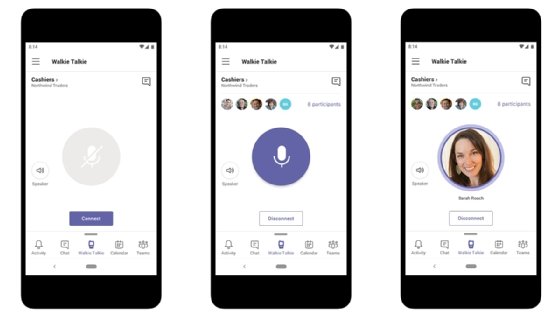
Saktanong - stock.adobe.com
Microsoft Teams to add smartphone walkie-talkie feature
Microsoft Teams is getting a smartphone walkie-talkie app. The feature is expected to launch in private preview by mid-2020.
Workers will soon be able to turn their smartphones into a walkie-talkie using Microsoft Teams. The feature is one of several Microsoft unveiled this week targeting so-called frontline workers, such as retail associates, nurses, housekeepers and plumbers.
The walkie-talkie feature will let groups of employees speak to each other by pressing a button in the Teams mobile app. The audio will travel over Wi-Fi and cellular networks, meaning users will be able to communicate with colleagues anywhere in the world. The feature will be available in private preview in the first half of 2020.
Many retailers, hospitals, airlines and hotels still rely on physical walkie-talkie devices. In recent years, startups like Orion Labs and legacy vendors like Motorola Solutions have begun selling smartphone walkie-talkie apps. Those mobile apps come with benefits like location tracking and integration with other business technologies.
Microsoft's smartphone walkie-talkie feature is not innovative. But if it works well, the capability could help Microsoft boost adoption of Teams among workers who otherwise wouldn't use the app. Microsoft has made targeting frontline workers a priority since late 2018.
In addition to the walkie-talkie app, Microsoft said Thursday it would add to Teams a task feature for creating and assigning small projects to employees. The system will give businesses a dashboard to track tasks in real time across multiple departments or store locations. It will launch in the first half of 2020.
Microsoft will also expand the scheduling capabilities of Teams by integrating the app with popular workforce management platforms by Kronos and JDA Software. Those integrations will let businesses keep existing scheduling software in place while giving workers the ability to swap shifts and request time off through Teams.
Microsoft is not the only collaboration vendor targeting frontline workers, said Rob Arnold, analyst at Frost & Sullivan. But Microsoft has a leg up on competitors because it can offer businesses so many complementary cloud services. Those include the customer relationship manager Dynamics 365 as well as e-commerce and Internet of Things (IoT) platforms within Microsoft Azure.

New identity and access features for Microsoft Teams
Additional features targeting frontline workers include SMS sign-in, off-shift access controls and shared-device sign-out. These features will roll out between now and the middle of the year.
Workers will soon be able to sign into their Azure Active Directory account (which controls access to Teams) using only a mobile phone number. IT admins will decide which groups of employees use the method.
IT admins will also be able to prevent frontline workers from accessing Teams when they are not on the clock. Temporarily blocking access will help businesses comply with labor laws.
Finally, for Android, Microsoft will add an "end shift" button to shared mobile devices and tablets that will clear app logins and browser sessions. Purging that data will prevent employees from accessing information they shouldn't.
Collectively, the latest features show that Microsoft wants to take Teams beyond the 30% of corporate employees who work in offices, Irwin Lazar, an analyst at Nemertes Research, said. "I think Microsoft is aggressively trying to expand the reach of Teams."







